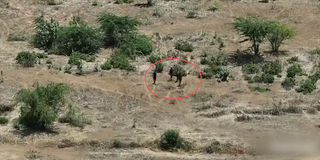Premium
Mystery deepens over helicopters’ role in bandit-ridden Samburu, Baringo counties

A section of Isiolo-Kachuru route pictured on April 20, 2023. The helicopters are mentioned in numerous security meetings with Baringo and Samburu residents and police reservists claiming they usually land in bandits' hideouts and whenever they are sighted, attacks follow.
What you need to know:
- Seven poignant questions stand between unlocking puzzle of low-flying helicopters.
- The helicopters are mentioned in numerous security meetings with residents and police reservists claiming they usually land in bandits' hideouts.
For the past two years, mysterious helicopters have been spotted hovering over the rugged terrain of Baringo and Samburu counties.
Their low-flying silhouettes, often seen in areas notorious for banditry and lawlessness, have sparked a frenzy of speculation and concern among local residents and authorities alike.
Who flies these planes? Why are they shrouded in secrecy? What clandestine mission draws them into the heart of criminal activity, in defiance of law and order? What cargo do they carry, hidden from prying eyes? Who benefits from their shadowy operations, and at what cost to the security of the region? Also, how have they succeeded to evade radar detection and law enforcement efforts thus far?
And perhaps most urgent, what measures will authorities take to ensure that this potential threat is neutralised and safety of the community restored?
These are the hard questions authorities in the Rift Valley are facing even after it emerged that a directive to shoot down the mysterious choppers was issued on Monday.
Rift Valley Regional Coordinator Abdi Hassan ordered that the low-flying helicopters, which locals describe as blue and white in colour, should be brought down if sighted.
Mr Hassan said they are suspected of aiding criminal operations around Malaso Valley in Samburu County. But as the search for answers intensifies and the shadows deepen, the true nature of these aircraft remains unexplained.
"I have instructed our security officers to closely monitor the low-flying aircraft around Malaso, with the possibility of bringing it down. We have established that there is a connection between the helicopter and the bandits who are hiding inside the valley," Mr Hassan said.
Locals have long suspected the helicopters' involvement in criminal activity.

A seriously injured police officer is lifted into a police helicopter at Marigat for treatment in Nairobi on December 22; 2016. The police officer was shot on both legs on patrol when they were ambushed by armed bandits at Noosukro in Baringo South Sub-County.
"We suspect that they are being used to supply weapons to the criminals who are stealing from our people,” Samuel Ltunta, a local elder, said.
Last year, the government banned low-altitude flights over troubled areas in parts of Samburu West and the North Rift region.
Interior Cabinet Secretary Kithure Kindiki imposed the ban, citing reports linking unnamed influential figures to the use of helicopters to transport weapons to criminal gangs.
In response to the directive, Mr Hassan ordered residents living in bandit-infested zones to vacate them and prepare for an air operation to flush out armed criminals.
Areas like Siampu, Lkeek Sapuki, and Soit Pus have been identified as hotspots infiltrated by armed bandits.
"I appeal to those living in those areas that were gazetted as dangerous and disturbed to use the shortest exit route to allow troops opportunity to comb the areas," Mr Hassan said, emphasizing the urgency of the situation.
The administrator made the remarks during a visit to police officers injured in an accident while responding to an attack by bandits.
Former Rift Valley Coordinator - who is now Trans Nzoia governor - George Natembeya confirmed in an interview with NTV last year that private helicopters are used to ferry weapons to bandits in the troubled region.
The helicopters are mentioned in numerous security meetings with residents and police reservists claiming they usually land in bandits' hideouts and whenever they are sighted, attacks follow.
“The government knows. The National Intelligence Service has the list of perpetrators of the banditry,” Mr Natembeya said then, adding that the Kenya Civil Aviation Authority has always denied knowledge of the helicopters.
Impassable roads and poor network coverage continue to hinder security personnel's ability to respond effectively to attacks, worsening insecurity challenges in Samburu County.
On Sunday, an armored personnel carrier veered out of control resulting in injuries to 12 police officers who were responding to an armed assault in Siampu area, perhaps underscoring the dangers posed by inadequate road infrastructure.

Bandits captured during an aerial surveillance mission as part of the KDF's Operation Maliza Uhalifu in Kainuk, Turkana County.
Two people died in the attack with Samburu police boss Thomas Ototo saying the injured officers are being treated at the Samburu County Referral Hospital in Maralal town.
The lack of reliable communication has compounded the insecurity in Samburu, allowing bandits to evade detection and tend to strike swiftly and take off onto hiding.
Despite efforts to improve mobile network coverage, Samburu continues to suffer from unreliable connectivity, enabling bandits to exploit communication gaps.
Last week, Transport Cabinet Secretary Kipchumba Murkomen acknowledged the critical link between poor infrastructure and increased banditry, leading to the launch of a rehabilitation project to address security challenges posed by bandits operating in the region.
The initiative seeks to improve road conditions to facilitate security operations and enhance safety for residents and travellers.
"We have lost lives here as a result of banditry, and poor roads infrastructure is one of the major concerns. Our responsibility is to ensure that security operations are facilitated because good infrastructure reduces lawlessness and insecurity,” said CS Murkomen.





